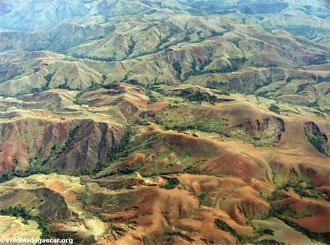- Africa’s deforestation rate may be underestimated by satellite imagery according to a researcher at the University of Wisconsin.
- Gibbs also said that the use of net estimates for deforestation can also mislead policymakers on the true rate of forest loss by masking the disappearance of ecologically important primary forests with the growth of secondary forests and commercial plantations.
Africa’s deforestation rate may be underestimated by satellite imagery according to a researcher at the University of Wisconsin.
Holly Gibbs, a Ph.D. candidate at the Center for Sustainability and the Global Environment at the University of Wisconsin, presented her findings at a conservation conference held in Antananarivo, the capital of Madagascar.
“The consensus is that Africa is losing about 0.4 to 0.7 percent of its forests each year but this is likely an underestimate,” said Gibbs. “If you have rain over an open woodland forest, common to parts of Africa, it will ‘green up’ or sprout flowers. If the satellite takes its image at that time it can have the impression that there is more forest as a result.”
Gibbs also said that the use of net estimates for deforestation can also mislead policymakers on the true rate of forest loss by masking the disappearance of ecologically important primary forests with the growth of secondary forests and commercial plantations.
Gibbs said that current remote sensing may only give a partial picture of the true extent of forest degradation and that more on-the-ground data was needed to get a better understanding of deforestation on the continent.
“We have to move beyond net estimates and look at gross rates of clearing to be able to fully assess the impact of human land use changes on Africa’s forests,” she added.
 Deforestation in Madagascar. Photo by R. Butler |
According to the Food and Agriculture Organization of the United Nations (FAO), Africa lost the highest percentage of tropical forests during the 1980s, 1990s, and early 2000s of any continent. In total, some 23 million hectares of forest disappeared in the 1980s while another 20 million fell in the 1990s. Most clearing results from subsistence agriculture, though logging and infrastructure development has also contributed to forest loss.
The impact of deforestation is one of the central topics being discussed at the Conservation International-sponsored meeting in Madagascar. More than 450 scientists, government representatives, and development experts have convened to discuss ways that sustainable management of ecosystems can help reduce poverty and hunger in Africa.
RELATED ARTICLES
Deforestation in Africa
The vast majority of Africa’s tropical moist and tropical rainforests exist in West and Central Africa. However, these forests are rapidly vanishing; according to the FAO, Africa lost the highest percentage of rainforests during the 1980s, 1990s, and early 2000s of any biogeographical realm.
Deforestation rates jump in Uganda and Burundi, fall in Rwanda January 25, 2006
Tropical deforestation rates have skyrocketed in Uganda and Burundi, while declining significantly in Rwanda according to mongabay.com’s analysis of data from the Food and Agriculture Organization (FAO) of the United Nations.
Goodbye to West Africa’s Rainforests January 22, 2006
West Africa’s once verdant and extensive rainforests are now a historical footnote. Gone to build ships and furniture, feed hungry mouths, and supply minerals and gems to the West, the band of tropical forests that once extended from Guinea to Cameroon are virtually gone. The loss of West Africa’s rainforests have triggered a number of environmental problems that have contributed to social unrest and exacerbated poverty across the region.
Nigeria has worst deforestation rate, FAO revises figures November 17, 2005
Nigeria has the world’s highest deforestation rate of primary forests according to revised deforestation figures from the Food and Agriculture Organization of the United Nations (FAO). Between 2000 and 2005 the country lost 55.7 percent of its primary forests — defined as forests with no visible signs of past or present human activities. Logging, subsistence agriculture, and the collection of fuelwood are cited as leading causes of forest clearing in the West African country.
Growing Pains and Growing Alliances: China, Timber and Africa. Timber hungry China moves into Africa April 20, 2005
China, as the fastest growing economy in the world, is poised to make significant impacts on the global market and the global environment, especially with its expanding involvement with nations rich in natural resources but deficient in economic and political stability. Nowhere is this more apparent than in Africa where China has rapidly bolstered its ties in recent years with the majority of the continent’s 54 nations.
Quotes attribted to Gibbs’ come from a Reuters article, “Rate of African forest loss underestimated: scientist”, written by Ed Stoddard.